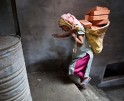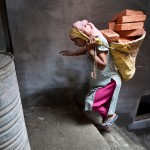Shinichiro Nagasawa: The Bonin Islanders
“We aren’t American. We aren’t Japanese. We are Bonin Islanders!”
— Stanley Minami, quoted in “The Bonin Islanders”
One of the pleasures of reviewing portfolios for the T3 Photo Festival Tokyo this past fall was meeting wonderful photographers and seeing great work. I was so intrigued by Shinichiro Nagasawa‘s project and book, The Bonin Islanders. The book was published by AKAAKASH in Japan.
The Bonin Islands are an archipelago several hundred kilometers south of Japan’s largest island of Honshu. Lacking an airport, it takes 24 hours by boat to reach the islands from Tokyo. The archipelago used to be uninhabited for a long time (the name “Bonin Islands” goes back to the Japanese word for “uninhabited”), until a few Westerners and Pacific Islanders settled here in the early 19th century. The history of the islands is short but complicated.
In the late 2000s, Japanese photographer Shinichiro Nagasawa came across an old photograph in a travel magazine showing European- or American-looking people wearing kimonos. Intrigued by the archipelago’s history – something he hadn’t learned about in school – Nagasawa felt an urgent need to visit the islands and photograph its inhabitants.
His book, The Bonin Islanders, explores the complex history of these islands as well as questions of identity, culture, nationality and independence through earnest interest, curiosity and warmth.
Born in Tokyo in 1977, Shinichiro Nagasawa creates works that explore societal contradictions and issues through an individual lens and a grounded sense of scale. In 2008, Nagasawa learned about the indigenous people of Chichijima, a remote island in the Ogasawara Islands, located 1,000 km south of Tokyo. Over the last 13 years, Nagasawa has dedicated himself to a project aimed at portraying the identity and history of Chichijima’s indigenous population, a group largely overlooked in Japan.
In 2021, he published a monograph “The Bonin Islanders” (AKAAKA). His major exhibition includes Nikon Salon (2021), T3 PHOTO FESTIVAL TOKYO (2022), PRIX PICTET Japan Award at TOKYO PHOTOGRAPHIC ART MUSEUM (2023).
Instagram: @shinichiro_nagasawa/
Instagram: @shashasha_book/Instagram:@akaakasha
“Nagasawa’s persistence in building meaningful relationships with the islanders and his developing understanding of their history and identity started a virtuous cycle that allowed him to create richer and more authentic portraits of people and the places that hold meaning for them.”
— from Harvard Art Museum director David Odo’s essay (included as an afterword in the book)
The Bonin Islanders
In 2007, I came across a family photo. In front of a thatched hut, there were two rugged- looking Western men, and behind them, three Western children standing dressed in Japanese kimonos.That’s when I learned of the indigenous people on Chichijima Island in the Ogasawara Islands, Tokyo, and in 2008, I headed to Chichijima to meet their descendants.
The Ogasawara Islands were once known as the Bonin Islands in Western countries. In 1830, five Westerners and twenty Kanakans (people from the Hawaiian Islands) settled on the then uninhabited Chichijima. The island became a Japanese territory in 1876 and Japanese started living there. Those who weren’t Japanese were half-forcibly naturalised and referred to as “Western Islanders.” During World War II, all islanders were forced to evacuate to Japan’s mainland. The islands were then occupied by the U.S. Navy for 23 years after the war, and during which time only Western Islanders were allowed to return to the islands. And finally in 1968, the islands were returned to Japan.
Stanley Minami was the first Western Islanders I met on the islands. When I asked him if I could film him, he told me, “Go home! We are neither American nor Japanese, we are Bonin Islanders!” His words reflected their identity, which had been tossed around by politics for so long. It made a mark on me.
I called them “Bonin Islanders” and continued documenting their lives.
In 2016, eight years after I began photographing them, I was shown their birth certificates from the occupation period of US Navy. Under race, it listed them as “Bonin Islanders.” It was then that I finally realised why Stanley Minami called himself “Bonin Islanders”– it was from their birth certificates. It was a genuine proof that they were born Bonin Islanders and lived as Bonin Islanders.
Posts on Lenscratch may not be reproduced without the permission of the Lenscratch staff and the photographer.
Recommended
-
Réhahn: Memories of ImpressionismJune 17th, 2024
-
Shinichiro Nagasawa: The Bonin IslandersApril 2nd, 2024
-
Photographers on Photographers: Barry Schwartz in Conversation with Jana AšenbrennerováJune 30th, 2023


































































